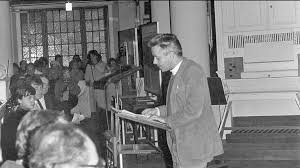This week, I nearly left Leipzig without visiting the Saint Nicholas church. When I first went past, it wasn’t open, and I decided that it probably wasn’t worth trying again later. But, in the end, my wandering around the city centre brought me back near the church, so I popped in after all.
 |
| The St Nikolai Church in Leipzig |
The former nation of East Germany referred to itself as the ‘German Democratic Republic’ or GDR. It viewed itself as democratic because its leaders simply knew they were doing the right thing by the people. It didn’t matter that most of the people didn’t agree. Naturally, if you’re doing the right thing, there’s no need to tolerate any dissent, because opposition must, by definition, be wrong. Sadly, that’s an attitude that seems increasingly common in the West too these days.
After four decades of this rule, the people of the GDR were sick to death of the lack of opportunity their tiny country offered them, coupled with the near impossibility of ever leaving it, surrounded as it was by prison-like fences. The paradoxes bloomed. A friend I met when I visited East Germany in 1982, told me he’d suffered the wrath of the authorities for having Western magazines in his possession. His penalty was to interrupt his university of studies for a year and work as a carpenter instead – in a regime that trumpeted the nobility of manual labour, actually having to do some was regarded as a punishment. More serious offences could lead to far worse consequences: an illegal attempt to leave could even cost you your life.
Strangely, however, the one institution the state never fully brought to heel was the Church. That led to frustrated Leipzig citizens attending services every Monday in the Saint Nicholas Church, to take part in ‘peace prayers’. Week after week growing numbers attended, eventually spilling into the streets. As the Church itself admits, the vast majority of the people clamouring to get in to the services weren’t Christians. They were just thirsting for the right to express a democratic disagreement with the self-styled democrats who ruled them.
And they did it without violence: the Monday meetings truly were peace prayers.
 |
| Christian Führer speaking to one of the Monday meetings A movement without a leader that brought down an autocratic regime |
Asked when this would happen, the spokesman checked his notes, realised he hadn’t been briefed on a date, and answered, ‘well, now, I suppose’.
From both sides, thousands descended on the checkpoints demanding that the guards open the gates. They checked out the spokesman’s words themselves and, having confirmed he’d really spoken them, they lifted the barriers and the crowds surged through. Some climbed on to the wall, an act that would have been met with gunfire just hours earlier, and with sledgehammers, or pickaxes, or even just chisels, began to chip away at a hated symbol of oppression.
And I might have missed a visit to the place where this all started…
The wall has now been down for longer than it was up. Saxony, the German province of which Leipzig is the biggest city, had been celebrated down the centuries as a centre of elegance and beauty. It is again today. I was enchanted by the arcades and covered passaged linking streets in the centre, the soaring spires and older buildings alongside glorious new structures – I fell at once for the University building – where everything fits despite the contrasts of period and style.
 |
| The new University building Leipzigers have kept their sense of style |
‘They’re Dubček’s revenge,’ he told me, referring to shameful moment when East German troops had joined Soviet forces in invading what was then Czechoslovakia to overthrow the liberal, reforming government that Alexander Dubček had formed.
It was also he who told me about the East German rulers' attempts to win hearts and minds in the population. The kids, he said, were bombarded with propaganda from the day they started school. And it worked, he reckoned, right up to the day that they got their first taste of Western chocolate. Suddenly, the contrast of life in East and West swung dangerously to favour the West.
Rather less amusing was his account of his own life. It was one of those things that I should have realised but hadn’t: people like him had been born into a democracy and then, like all of Germany, seen it strangled by Nazi totalitarianism. However, unlike the West, the citizens of the East had seen no return to democracy after the war but four more decades of authoritarian rule. Nothing like as awful as the Nazis, but no democracy all the same. A depressing fate.
Not everything’s better, though. On top of the reputation for elegance, and then for defying power in the name of freedom, Saxony is now building a new reputation as the centre of the far right in Germany – outside Leipzig, it’s true, remains attached to its liberalism. But in the countryside intolerance and xenophobia have grown, as among Trump circles in the States or Brexit supporters in Britain.
It may be time to get those peace prayers going again in the St Nicholas Church.

No comments:
Post a Comment